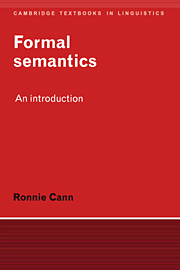Book contents
- Frontmatter
- Contents
- List of figures
- Preface
- List of symbols
- 1 INTRODUCTION
- 2 PREDICATES AND ARGUMENTS
- 3 NEGATION AND CO-ORDINATION
- 4 TYPE THEORY
- 5 THE LAMBDA OPERATOR
- 6 QUANTIFICATION
- 7 INFERENCE
- 8 TIME, TENSE AND ASPECT
- 9 POSSIBLE WORLDS
- 10 INTENSIONAL SEMANTICS
- Answers to selected exercises
- References
- Index
10 - INTENSIONAL SEMANTICS
Published online by Cambridge University Press: 05 June 2012
- Frontmatter
- Contents
- List of figures
- Preface
- List of symbols
- 1 INTRODUCTION
- 2 PREDICATES AND ARGUMENTS
- 3 NEGATION AND CO-ORDINATION
- 4 TYPE THEORY
- 5 THE LAMBDA OPERATOR
- 6 QUANTIFICATION
- 7 INFERENCE
- 8 TIME, TENSE AND ASPECT
- 9 POSSIBLE WORLDS
- 10 INTENSIONAL SEMANTICS
- Answers to selected exercises
- References
- Index
Summary
Modelling intensions
In Chapter 9, an interpretation of the modal adverbs necessarily and possibly was presented in terms of possible worlds, but the other contexts in which extensional entailments fail were not discussed. As proposed in Section 9.2, the general solution to the problem of referentially opaque contexts lies in the concept of intensionality, but the interpretation of modality given above was not stated in terms of this concept and it has not been made clear how possible worlds enable a formal definition of intension to be made. Let us now remedy the situation and provide a general semantic theory for opaque contexts, thus completing our survey of formal semantic theory.
The definitions for the interpretation of modal formulae given in Chapter 9 embody the idea that formulae may be true in some worlds but not in others, i.e. that the extensions of formulae (i.e. truth values) may vary from world to world. Furthermore, it was suggested at the end of Section 9.2 that an intension is something that picks out the extension of an expression in any state of affairs. The intension of a formula may thus be defined as something that specifies its truth value in every state of affairs. Equating states-of-affairs with possible worlds, we interpret the intensions of formulae as functions that map possible worlds onto truth values: functions that map a possible world onto 1 if the formula is true in that world and onto 0, otherwise.
Information
- Type
- Chapter
- Information
- Formal SemanticsAn Introduction, pp. 282 - 322Publisher: Cambridge University PressPrint publication year: 1993
